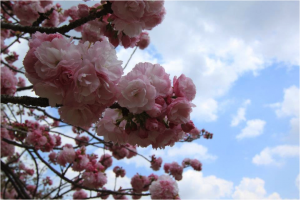10 reasons to visit… China
China is an amazing country, one that should be on every traveler’s must visit list. Few countries possess the wide variety of experiences you will find in the Middle Kingdom. While you are in this amazing country, be sure to visit the province of Yunnan, one of the lesser known, but most beautiful destinations within China. Here are ten terrific reasons why you should visit China, by Anna Smith, who studies Chinese in China at Keats School.
1. Breath-taking landscapes
As one of the largest countries in the world, China boasts incredibly diverse landscapes. Virtually whatever scenery you find most beautiful, you will find it in China. From the Northwest deserts to the Southeast seacoast, high mountain ranges to fertile plains, the frozen beauty of Harbin to the lush warm tropics of Xishuangbanna, China has it all. Hangzhou is famous for its stunning West Lake views. Suzhou has beautiful garden views and winding rivers with traditional architecture. And Hainan is the tropical paradise of the Orient; known as the ‘Eastern Hawaii’; it is China’s own paradise island.
2. Wonderful people
As the most populous nation in the world, China has plenty of people to meet. Chinese people generally love Westerners, so most are quite friendly. Everywhere we go, people want to stop and chat and take pictures with us. You can meet some amazing people and hear many intriguing life stories in the Middle Kingdom.
3. Awesome language
To a native English speaker, Mandarin can seem intimidating because it is so different to European languages. But this uniqueness makes it all the more beautiful and amazing to experience. Chinese characters are stunningly beautiful. Listening to tonal Mandarin can be like experiencing a new kind of music for the first time. If you already playing with the thought of challenging yourself, then you should definitely check out these reasons to study Chinese at Keats School.
4. Incredible food
While known for its tea and rice, there is much more to Chinese cuisine than is commonly known by most Westerners. And this cuisine varies greatly by region. In the north, noodles are the most common meal staple, but in the south, almost everything is served over rice. Different regions, like Sichuan and Hunnan, are known for their unique spicy food, while coastal regions boast a variety of seafood. Some of the most fun and interesting foods to try are street foods, such as roasted sweet potatoes and Chinese barbecue, shao kao.
5. Rich history
Few places have such a vast and rich history as the Middle Kingdom. The Great Wall of China and the Terracotta Warriors are some of the most well known ancient tourist attractions. The Forbidden City and Temple of Heaven in Beijing are also must-see attractions to learn about Chinese history and culture.

Royal Palace, Lijiang. Ancient traditional buildings can still be easily seen in many cities in China.
6. Modern development
At the same time, China boasts some of the largest cities in the world and is becoming more modern everywhere you look. Nowhere else have I ever seen so many high rises or amazing skylines as in China. Shanghai epitomises modern day China, with the famous modern riverfront skyline known as the Bund, large European style buildings, and its particularly distinctive Pearl of the Orient tower.
7. Amazing markets and exciting products
True, China makes a wide variety of products that are exported all over the world, but they have many unique products as well. Fine silks, exquisite China tea sets, elaborately carved jade, and expensive aged tea are some of the most sought after high-priced commodities. But Chinese Calligraphy, bamboo baskets, traditional Chinese knots, and other handcrafted items are distinctly beautiful as well. Provinces in the southwest of China have a wide variety of unique items hand crafted by the many minorities within its borders.
8. Fascinating diversity
One of the most amazing things about China is the variety of experience that can be enjoyed in one place. Old and new, sweet and spicy, rough and smooth, all combine into a rich cultural tapestry. Because of its ethnic and topographical diversity, Yunnan holds incredible diversity in one province.
9. Mind-blowing memories
Because there are so many unique and diverse things to experience, a trip to China is sure to create some incredible memories. These experiences will travel with you for the rest of your life. My family and I have experienced so many wonderful memories. Especially exciting to my young boys are eating jiaozi and watching fireworks during Spring Festival. Our experiences shape who we are as people. One of the best reasons to visit any new place is to literally expand your horizons, as it can change your thoughts and life. China’s incredible variety allows you to enjoy a multitude of new experiences and will forever change you.
10. Charming calligraphy
The ancient art of Chinese calligraphy cannot be fully appreciated without visiting China and seeing masters create their works of art in person. Even in the smallest shop, a true master can create amazing works of art. Words become art to be enjoyed be all, even if you don’t understand the meaning. But there are many places where you can learn famous Chinese sayings and begin to learn Chinese calligraphy for yourself, which deepens your admiration for its beauty even more. Being able to write in Chinese is a very valuable skill, but often feels impossible to learn. Once you understand the fundamentals, you will see that this is indeed something that you can learn.
Anna Smith
You can’t beat visiting China for learning the language – but before you go, remember to learn a few basic words with uTalk to get you started.
10 reasons to visit… Tokyo
To finish up our Japanese week, Safia’s written today’s blog post on her top ten reasons to visit Tokyo.
Do you live in Tokyo, or have you visited? Please share your own top tips in the comments!
1. The old and the new
Before I even start talking about specific points of interest, all you need to do is to walk down the street to see how traditional and modern Japanese culture both collide and sit beautifully side by side. Temples of all shapes and sizes pop up everywhere in between buildings and houses (many of which are open to the public), kimonos and yukatas are still worn as everyday wear and not just for special occasions, and I will never stop being excited about literally being able to buy anything under the sun from a vending machine.
2. Harajuku/Meiji Temple
For the weird, the wonderful and the fandom, Harajuku is the place to be to find the centre of Japanese youth and fashion culture. If you like to people-watch, there are usually a handful of cosplayers or colourfully dressed youths hanging around the station area and the backstreets are packed with little independent boutiques. In stark contrast, Meiji Jingu is also located here with the entrance round the corner from the station, and is an Imperial Shrine dedicated to Emperor Meiji and his wife Empress Shoken. If you’re lucky enough you may even get to see a wedding, as it is a popular venue for forthcoming nuptials.
3. Tsukiji Market
There are very few places in the world where I would consider waking up at 5am just to get some fish, but Tsukiji Market is definitely one of them. If the idea of raw fish (sashimi) sends you heaving, I urge you to give it another go for the love of tuna that just melts on your tongue. I promise when it’s this fresh and prepared this delicately there is nothing else like it, and there will be plenty of other sushi options as well. Personally as a foodie, I skipped straight to the food, but if you want to see the tuna auction you really have to get there early as there are limited spaces for viewers. Some of the queues for the restaurants can get quite long as well, but surely that’s just testament to how good it’s going to be inside?
4. Boat ride on the Sumida River
Take a journey down the river and under its many bridges to see Tokyo from a different point of view. Jump on at Asakusa where most of the water buses start from and you’re guaranteed to see at least twelve different bridges along this route. If architecture and design spark your interest then this is definitely a trip for you. And if sipping a cool beer on a boat on a sunny day sparks your interest then I’d say this is a trip for you too! There are various routes including a round trip, but I can recommend getting off at the Hama-rikyu gardens for an added sightseeing bonus.
5. Food
When it comes to food, where do I even start? I wouldn’t blame you if the first thing that came to mind was sushi followed swiftly by ramen, but there is so much more to Japanese cuisine. This section deserves its own blog post, but before I get too tempted let me recommend three things that I think you should definitely try on your trip (that doesn’t include sushi or ramen!):
Takoyaki (Octopus balls)
Bearing in mind that’s a literal translation, takoyaki is a batter cooked in a special pan filled with diced octopus, pickled ginger and various other ingredients, all brought together in a handy bite-sized ball.
Okonomoyaki (Grilled savoury pancake)
Quite often this pancake-like dish is cooked on a hot grill right in front of you with the main ingredient being cabbage. Be sure to check if it’s a grill-it-yourself establishment so you’re not sitting there twiddling your thumbs while everyone else is already tucking in!
Yakitori (Skewered food)
Basically, meat on a stick (and sometimes vegetables) but with some amazing local flavouring. If you can find it, there’s a brilliant little alleyway in Shinjuku where local eateries are crammed in next to and top of one another.
6. Izakaya
I can only describe an Izakaya as a cross between a pub and a tapas restaurant in a laid back and cosy setting. Although they can at first seem intimidating to a foreigner, they’re great for unwinding after a long day of sightseeing (or work) and getting acquainted with the locals. If you’re having a tough time looking for one, many still sport a traditional red lantern outside the premises. Food comes as and when ordered and ready rather than in courses and is usually shared between the group if you’re with other people.
7. Karaoke
Surely it’s not possible to go to the motherland of karaoke without actually going to a karaoke bar at least once? Even if you don’t like karaoke, you’re in another country and no one will ever know, unless you accidently post a picture on Facebook. So lose your inhibitions, grab that mic and belt out some tunes in a foreign language! Japanese karaoke is an altogether individual experience and there are such a variety of bars and boxes to choose from, whether you’d like to be surrounded by Hello Kitty memorabilia or even sing from a hot tub. Check out the Shibuya and Roppongi areas as a starting point.
8. Tokyo Tower
At a whopping 634m tall, Tokyo Tower is hands down one of the best ways to survey the city. If you need a break from the bustling streets below, I highly recommend popping up and having a little gander. The night time view is spectacular with Tokyo’s array of high rise buildings and bright lights. During the day if you’re lucky enough to have a clear sky, then you may even get to see some distant points of interest which are very handily marked around the tower for you, such as ‘Mt. Fuji, 97km, that way’.
9. Sakura (Cherry Blossom) season
Around April something magical happens in Japan and it’s called Sakura or Cherry Blossom season. As it’s seasonal the exact time of the year can vary, but if you manage to catch it the flurry of pink and white blossoms can be breathtaking. Sakura hot spots in Tokyo include Shinjuku Gyoen and Ueno Park, both boasting over 1,000 Sakura trees. Be prepared for crowds during peak season as popular areas can get amazingly crowded with Sakura enthusiasts.
10. Asakusa/Sensou-ji Temple
Asakusa definitely has a bit more of an older feel to it compared to some of Tokyo’s other more shiny districts like Ginza. Many of the buildings were built around the 1950s/60s since prior to this most were lost to bombs in war. This included one of Tokyo’s most popular temples Sensou-ji, which was originally built in the 7th century. It was rebuilt after WWII to symbolise peace and rebirth to the Japanese people. To get to the temple you’ll need to navigate your way through the Nakamise shopping street, which is lined with various street food stalls and tourist shops.
One final piece of advice – don’t assume that everyone in Tokyo will speak English, because they don’t! You’ll need to learn at least a few basic phrases before you get there.
Fortunately, there’s an app for that 😉
Safia
All photos property of Safia Griffin
Che dice la nostra cultura quotidiana di noi?
Today we’re excited to share our first ever bilingual post, written by Lucy, who’s just returned from four months in Rome as part of her university studies. In this post, she talks about a few typical Italian habits she noticed during her time in the city and some of the (slightly surprising) questions she had to answer about British culture.
Don’t speak Italian? There’s an English translation below. And if you’d like to join the conversation, you can do so in the comments or on Twitter – see the end of the post for details.
Benché esistano delle centinaia di diverse abitudini italiane, dal nord al sud, dalle montagne alle coste, almeno si trova una percettibile concordanza di “modi di fare” di base che abbraccia il paese: si mangia la pasta ogni giorno, si offre l’opinione se richiesto o non, e non si telefona mai durante l’ora di pranzo (entro le 1300 e le 1500). Non essendo italiana me stessa, trovavo un po’ strano queste regole seguite persino dai giovani come se fossero ordinate dal Papa. Era solo quando mi sono resa conto che sono imposte invece dalle matriarche che iniziavo a capire le sue importanza. C’è una convivialità e un autentico rispetto per il comportamento che insieme danno un metodo alla follia.
Cercavo di integrarmi bene e cordialmente in queste situazioni, e mi piaceva molto imparare questi “si fa” e “non si fa”. Gradualmente mi abituavo a tenere lo sguardo durante il brindisi, a rivolgermi ai vecchi con “Lei” e non “tu”, e di avere pazienza quando facendo una fila perché non si sa mai quanto lungo sarebbe.
Una delle gioie dell’anno Erasmus e che s’incontra delle persone non solo da diversi paesi ma di varie origini, e si tocca di spiegare le sue proprie radici. Qualche volta è più difficile che abbia mai pensato. Vi lascio una manciata di domande che mi capitavo di rispondere durante le 4 mesi che ho passato in Italia:
Perché gli inglesi mettono la moquette dappertutto nelle case, e poi mettono sopra i tappetti?
Questo mi ha sorpreso perché mi chiedevo quasi ogni giorno il ragionamento dietro la mancanza della moquette nell’appartamento che stavo affittando. Storicamente indovino che fu una mostra di stravaganza perché gli sconti per pulirla dovettero essere esorbitanti. Potrebbe essere anche per aggiungere un po’ di calore nelle stanze.
Perché non apprezzate il vino invece di berlo troppo a causa dei giochi di bevanda?
Sono consapevole della riputazione che noi inglesi abbiamo per l’abuso dell’alcool, e a dire la verità, mi vergogna di questo nostro status mondiale. Pero, difendo questa cultura solo un’iota per porre che almeno non abbiamo paura di essere scemi, e questa propensità gli italiani si manca.
E la pioggia…?
Gli italiani che incontro sembrano di avere una vera inquietudine per la mia salute quando imparano che piove più di una volta alla settimana in Gran Bretagna, anche durante l’estate. Ho anche qualche amico italiano che ha sinceramente basato le scelte di università sul clima. Quando si viene da un paese dove il sole brilla nell’estate e la neve cade nell’inverno, scommetto che sarebbe difficile immaginare qualsiasi altra realtà, ancora meno la timorosa pioggia!
Alla fine del mio soggiorno in Italia, avevo la sicurezza di dare direzioni a una taxista con attenzione risoluta, e di rifiutare con cortesia le proposizioni di una vecchia sull’autobus di una cena con la sua nipote (chi tra l’altro sta studiando per diventare medico). Pero, al momento in cui qualcuno mi dà un pezzo di frutta, non sarò mai in grado di mangiarla con le posate, mi dispiace. Certe consuetudini naturalmente resteranno per sempre entro il paese, ma vi consiglio, ansi vi sfido di immergetevi nella cultura italiana e di imparare qualche maniera nuova – vi prometto che vi farà sorridere!
Avete scoperto un’abitudine intrinsecamente italiana che vi è piaciuto mentre stavate in Italia? Condividerlo con noi, lasciando un commento, oppure su Twitter @EuroTalk #abitudineitaliana
What does our everyday culture say about us?
Although there are hundreds of Italian mannerisms, from north to south, whether in the mountains or at the coast, there is a distinguishable way of doing things that brings the country together: they eat pasta every day, they offer their opinion whether asked for or not, and they never phone anyone at lunchtime (1pm-3pm). Not being Italian myself, I found these rules, followed by young and old alike as if handed down by the Pope, a little difficult at first. It was only when I realised that they were actually imposed by the head of the family (the matriarch) that I began to understand their importance. This culture of conviviality, backed by a genuine respect for courtesy, offers a method to the madness.
I tried my best to integrate myself in these situations, and I really enjoyed learning the “do’s” and “don’ts”. Gradually I got used to looking someone sternly in the eye whilst clinking glasses for a toast, to using the third person singular when addressing someone older than me, and to keeping my patience when queuing for anything, because you can never know how long you’ll be waiting.
One of the many joys of an Erasmus year is that you meet people who are not only from different countries but varied backgrounds, which means you are also tasked with explaining the reason to your rhyme. This is often harder than you’d have ever thought. Here are a few questions that I had to reply to during my four months in Italy:
Why do English people put carpet everywhere in the house, and then put rugs on top?
This question really surprised me because I’d been wondering why there wasn’t any carpet to be seen in the apartment I was living in. I guess that historically, carpet was a demonstration of extravagance because the cost of cleaning them would have been extortionate. It could also be because carpet adds warmth to a room.
Why don’t English people appreciate wine instead of drinking too much of it (for example in drinking games)?
I’m aware of the reputation that us Brits have for abusing alcohol and to tell you the truth, our world-renowned status is embarrassing. However, I’ll defend our drinking culture just an iota by proffering that at least we’re not afraid of looking a bit silly every once in a while, which is a propensity that Italians seem to lack.
And what about the rain…?
Italians that I have met seem genuinely worried for my health when they learn that it often rains more than once a week in the UK, even in the summer. I have a couple of Italian friends who have even based their university choices on the weather. I guess when you come from a country where the sun shines in the summer and the snow falls in the winter, it’s would be pretty difficult to imagine anything different, much less the infamous rain!
At the end of my stay in Italy, I had acquired the confidence to give firm directions to a taxi driver, and to politely decline offers from old ladies on the bus to have their grandson (who as it happens studies medicine) take me out to dinner. However, I’m afraid to say that if someone were to hand me a piece of fruit, I still wouldn’t ever be able to eat it with a knife and fork. Some customs will obviously stay forever within a country, but I recommend or even challenge you to immerse yourself in Italian culture and to learn a new quirk – I promise it’ll make you smile!
Have you discovered any fun intrinsically Italian habits? Share them with us by leaving a comment, or on Twitter @EuroTalk #abitudineitaliana
Lucy
Learning Mandarin: Never call your mother a horse, and other tips
Cameron’s spending a couple of weeks with us here at EuroTalk for work experience. In today’s blog post, he explains why he chose to learn one of the world’s most difficult languages, and gives his suggestions for anyone who’s thinking about taking up the challenge.
Are you learning Mandarin? What drew you to the language? And do you have any tips of your own to share?
 Mandarin is recognised as one of the hardest languages to learn in the world, but with great difficulty comes great reward, as Mandarin is also one of the most useful languages in the world. Mandarin is so useful because it is spoken by almost 15 percent of the earth’s population natively, which is almost 1 billion people, and this figure does not include non-native speakers like myself. Also, China is one of the economic and industrial giants of the 21st century, and it’s still growing. Therefore Mandarin is very useful if you want to do business with the people involved in the global superpower that is China. As well as the practical reasons, Mandarin is also a great language to learn for cultural reasons, because, as you probably know, when learning any language, the culture of that country comes hand in hand, and China has a fascinating culture with a rich history.
Mandarin is recognised as one of the hardest languages to learn in the world, but with great difficulty comes great reward, as Mandarin is also one of the most useful languages in the world. Mandarin is so useful because it is spoken by almost 15 percent of the earth’s population natively, which is almost 1 billion people, and this figure does not include non-native speakers like myself. Also, China is one of the economic and industrial giants of the 21st century, and it’s still growing. Therefore Mandarin is very useful if you want to do business with the people involved in the global superpower that is China. As well as the practical reasons, Mandarin is also a great language to learn for cultural reasons, because, as you probably know, when learning any language, the culture of that country comes hand in hand, and China has a fascinating culture with a rich history.
Furthermore, if you learn Mandarin, that adds an extra incentive to make a trip to China to practise your newfound passion, and what’s a better way to spend your holidays than walking the great wall of China or paying a visit to the Terracotta Army? Additionally, if you’re the kind of person who relishes a new challenge, Mandarin is the perfect language for you, because, as I previously stated, it’s one of the hardest languages to learn in the world. On top of this, Mandarin will also appeal to you arty types out there in the form of calligraphy; this is a form of Chinese writing that involves painting the characters onto special paper called Xuanzhi (宣紙).
The most important thing to remember when learning Mandarin is not to get overwhelmed by the vast number of characters in the language; in fact I wouldn’t even worry about characters until you become more advanced in the language. Instead, begin by focusing on the oral side of the language, in particular, the pronunciation of words. In Mandarin pronunciation is key, for example, the word ‘ma’ can be said in four different ways and means four different things, so be careful not to call your mother a horse by pronouncing this word wrong!
A good thing to use to mark your progress of learning Mandarin is the HSK exams. These exams are held once a month and there are numerous different levels to work through, ranging from beginners exams to exams for people who are almost fluent, as well as the added bonus that they are recognised qualifications throughout China.
Good luck!
Cameron
If you’re interested in learning Mandarin, you can get started completely free with uTalk for iOS. Enjoy!
Easter celebrations around the world
Here in the UK, this weekend is Easter weekend. Many people will be marking the occasion by attending church services on Good Friday and Easter Sunday, while a more commercial tradition is to exchange chocolate eggs as gifts. Easter is a religious holiday, marking for many people around the world the death and resurrection of Jesus, but it also represents new life, falling as it does in spring time, and is often symbolised by young animals, like lambs and chicks.
We decided to have a look at some Easter traditions around the world, to see how other countries mark this holiday. Here are just a few:
Brazil
Mardi Gras (which means ‘Fat Tuesday’) takes place in Rio de Janeiro on Shrove Tuesday and marks the start of Lent. The streets are filled with large processions of people in brightly coloured, exotic costumes, marching, singing and dancing.
Another Brazilian tradition is to create straw dolls to represent Judas Iscariot, then destroy them in the street.
France
 Church bells are silent as a sign of mourning from Maundy Thursday until Easter Sunday. Sometimes children are told the bells (known as ‘cloches volants’ or ‘flying bells’) have gone to see the Pope and will return with Easter eggs.
Church bells are silent as a sign of mourning from Maundy Thursday until Easter Sunday. Sometimes children are told the bells (known as ‘cloches volants’ or ‘flying bells’) have gone to see the Pope and will return with Easter eggs.
In parts of southwest France, a giant omelette is made on Easter Monday. The dish can feed 1,000 people.
Ethiopia
During Lent in Ethiopia, Christians don’t eat or buy any animal products like meat, eggs, butter, milk, yogurt, cream and cheese.
The first Easter day service starts at 8 p.m. on Easter Saturday and lasts until 3 a.m. on Easter Sunday.
After the service, people will return to their homes and have a breakfast of ‘dabo’ sourdough bread to celebrate the end of Lent. Traditionally, the bread is cut by a priest or the head man in the family.
Czech Republic and Slovakia
As part of an Easter tradition, women and girls are beaten with decorated hand made whips on Easter Sunday. But despite what you might think, this is actually a good thing; the whipping is thought to make women more healthy and beautiful, and girls who don’t get whipped are often quite offended!
Chios (Greek Island)
In the village of Vrondados, the annual ‘war of rockets’ is staged between two churches, Agios Marcos and Erithiani. Residents spend all year preparing thousands of firework rockets and on the evening of Easter Saturday, the rockets are fired between the two churches for hours.
The custom goes back many years, and although there are plenty of stories, no one is quite sure how the tradition began.
Spain
Many towns and cities in Spain celebrate Semana Santa (Holy Week) with processions through the streets at night. Floats called ‘tronos’ are carried through the streets. Each float bears huge decorated figures representing part of the Easter story. It takes 40-50 people to carry each trono on their shoulders and processions can last between 4-5 hours.
In Murcia, a trono telling the story of the Last Supper has real food on the table. On Easter Sunday, the 26 men who have carried the table in the procession sit down and eat the food.
Please share your own Easter traditions in the comments. And whether you celebrate Easter or not, we hope you have a great weekend.
Seb












